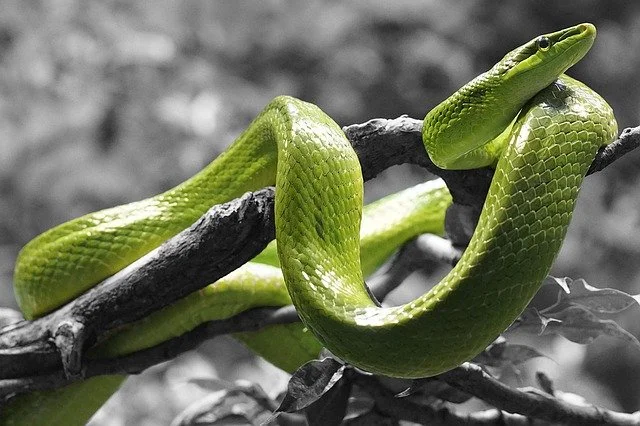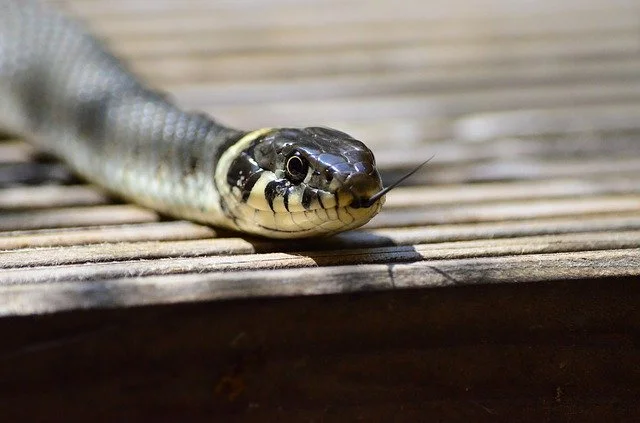How to get snakes out of your house

What is the best way to get rid of all of the snakes in the house? As you may be aware, getting rid of poisonous snakes that have taken up residence in your home is a difficult job. However, you should know where to begin combating reptiles since good preparation is half the battle.
Snakes have long been a concern for humans, particularly those who live in rural regions. When there is a chance of snakes in the home, people feel frightened to leave their rooms and to go to bed. If you fit the bill, don’t you think it’s past time to take action?
Snakes prefer to dwell in warmer regions. They creep across towns and reserves, and sometimes into people’s homes. While precautions are taken to keep snakes out of the house, there is always the danger of them getting in, particularly during the summer. Although not all snakes are poisonous, it’s important to remain cautious.
Analyze the danger
Do not use a broom or a stick to fight the snake. Unless you pose a danger to the snake, it will not attack you. Snakes, whether poisonous or not, do not attack people unless they are provoked. Remember that you are a bigger predator, and if you do not disturb the snake, it will stay quiet.
If the snake lifted its head and opened its jaws wide, it is most likely reacting to your presence. To escape the repercussions, gently back away from the snake.
Snakes are an important part of the ecology because they regulate rodent and insect populations. While you may not like having it in your house, you should not kill it since it helps to reduce the number of bug pests. Prevent snake cruelty by leading by example and don’t kill them out of fear.
Determine whether or not the snake is poisonous
Snakes’ venomousness may be determined in a variety of methods. Venomous snakes have a big body, huge fangs, and small eyes, among other characteristics. You should also keep an eye out for a rattlesnake, which is a well-known warning indicator.

If you think you reside in a poisonous snake-infested region, you need to know which species your invader is. The following are the four major kinds of poisonous snakes:
1. Snake with a copper head: It’s a rattlesnake with a dark copper hue. The bite of a snake-like this is very painful and seldom deadly.
2. Coral Snake: The most hazardous of the four is this one. The red, yellow, and black stripes on these snakes help to identify them. It’s worth mentioning that, owing to their similar coloration, they’re sometimes mistaken for striated king snakes, which are completely harmless. The pattern on the thorax of these snake species differs, despite their coloration is similar. The striped king snake is distinguished from the coral snake by phrases such as “red on black is Jack’s buddy” and “red on yellow is murdering a friend.
3. Water Snake: It has an olive-brown body and moves quickly. When they detect danger, these snakes emerge from the earth and expel a material that resembles cotton from their lips.
4. Rattlesnake: This is the most well-known and recognized snake. This snake has a rattlesnake tail and is brown with lighter stripes.
There are also a variety of vipers, cobras, and other poisonous snakes. Find out which snakes live in your region by reading the wildlife brochure. Recognize the snakes in your region. You will always be prepared for the worst in this situation.
Remove any animals or young children from the area where the snake has crept. It doesn’t matter whether the snake is dangerous or not; it’s better to avoid any potential risk.
Pets and children are more vulnerable than people due to their size. Their behavior is often unpredictable, particularly when it comes to pets, which may irritate the snake. Take them out of harm’s path in a calm manner so you may get rid of the snake without difficulty.
If you believe a snake has bitten your pet, take it to a veterinarian or contact the national poison control service. The bite may cause redness, swelling, or bruising on the animal’s torso. If this occurs, you must act quickly to avoid additional worsening of the illness, if not death.
What is the best way to get rid of a snake?
Keep a safe space between yourself and the snake
Even if you have strong doubts about the snake’s poisonous nature, you should avoid approaching it. However, do not leave the snake alone, since it may slither away, and you should avoid approaching it. If the snake is crawling and you believe your presence is encouraging it, leave the area immediately and contact animal control.
With a broom, open the door and push the snake out
Only do this if you’re certain the snake isn’t poisonous. Using a broom to drive the snake away is not a good idea. Just attempt to get it out by opening the door. Because the existence of a snake in the home is almost certainly an accident, it may want to leave as quickly as possible.
The snake’s mobility should be limited
The best option is to use a thick blanket or a laundry basket. If the snake is disturbed, it will instantly settle down after you cover it. It will no longer feel threatened if it does not see you or the surrounding area.
Place heavy items around the perimeter to keep the snake from sliding out from beneath the cover and slithering away. You’ll have more time to figure out how to get rid of the snake.
Take the snake out into the open. Do not attempt to transfer it from its current location if you are still unsure about the snake’s venomousness. Before touching the snake, remember to put something on your hands, such as gloves or mittens. Slowly approach the snake to avoid scaring it away.
It’s better to grab the snake by the belly and pull it closer to the tail. Squeeze the bottom of the snake’s belly, but not too firmly. Avoid putting too much pressure on the snake’s torso. Allow it to crawl on your palm to make it feel more secure. Remove it from your house and reintroduce it to its natural environment.
If you’ve covered the snake with a blanket or other piece of fabric, you may just carry it outdoors with the blanket. Avoid squeezing it too hard, particularly because it can’t see where it’s being carried.
Make a call to animal control and request a professional to assist you in getting rid of the snake. If you have already covered the snake with anything and do not wish to remove it yourself, this is the ideal option. The snake will be caught and released away from your property by the expert.
Keep your distance from the snake. Do not attempt to capture the snake if it is out of sight, but you know it is lurking in a closet or other confined area. Remove all members of your family from the room. You can’t tell how poisonous a snake is because you can’t see it. It may be irritated as well.
You should also leave a snake alone if you see one outside your house. If the snake isn’t poisonous, you have nothing to fear. It’ll figure out how to get out of your yard on its own and won’t bother you in the least. If the snake is poisonous, you should flee as soon as possible and seek expert assistance.
It’s never a good idea to attempt to kill a snake. When a human attempts to kill a poisonous snake, it usually bites.
Defending against potential peril
Snakes may wreak havoc on your house, so take precautions. While preventing snakes from entering your house is tough, you are unlikely to want the snake to slither towards you again. Because snakes like cold, gloomy areas, you should seal any basement openings bigger than 6mm in diameter.
Snakes may also get in via leaking window frames or doors, so make sure they’re shut tightly. Snakes may be kept out of your house by blocking any ventilation ducts or drainage pipes that lead in.
Determine the reason for the snake’s presence in your area. The presence of birds in the backyard or a big number of insects in the home can draw the snake to your location. However, getting rid of tiny animals that have been established in your house may be tough, particularly if they are a part of your ecology.
Getting rid of the rats is a must. Mice and rats are favorites of snakes. Pests are often introduced between the outside and interior walls of buildings since they are typically constructed of wood. If you hear a lot of scratching noises or find signs of mice in your kitchen, see a professional for help. Remember, if there aren’t any mice, there won’t be any snakes!
Leaving food for your pet attracts mice and, as a result, snakes. As a result, if your pet isn’t hungry, cover their food or bring food inside the home.
Mice may readily get into a home via holes the size of a pencil. If there are any gaps in your home’s walls, patch them right away. Appliances that emit high-frequency sound have also become popular for pest control, with good results. Keep in mind that snakes are constantly on the lookout for food.
Reduce the number of birds that make their homes in your yard. Snakes will be attracted to your garden even if you don’t deliberately attract them. Feeders will not only attract birds to your property, but also mice and rats that will eat the grains that fall to the ground. Although snakes aren’t particularly fond of grains, they are fond of creatures who eat them.
Natural bird repellents are seldom effective, and poisoning birds or snakes in your region is not recommended. If you want to get rid of birds in your yard, seal any gaps or holes in your house so they can’t use it as a nesting site.
Bird netting and sticky carpets may help keep certain birds away from your yard and prevent them from breeding. Intimidation techniques such as recording bird sound with danger warnings or exhibiting replicas of stuffed predators are also effective. You’ll have to try a few different things since birds are clever animals that adapt fast.
Make alterations to your garden. If you still can’t tolerate snakes, just encircle your yard with a fence. This will need the installation of a robust steel fence that can be enclosed. This fence should be slanted at a 30-degree angle to prevent snakes from crawling over it and entering your yard.
Small predators like snakes prefer to hide in gloomy, overgrown places, so grass and shrubs may also be cut. Because snakes prefer to hide in crevices between rocks, lime mortar should be used to seal them.
If you are concerned about your children or pets, you should enclose a small area where they may safely play to reduce the chance of snake contacts.
Warnings
Prepare yourself by learning about the many kinds of snakes that may be found in your region. Poisonous snakes are not present in all areas, but it is preferable to be aware of this in advance, particularly if they are the snakes that dwell in your neighborhood.
After being bitten by a snake, you should not attempt to travel to the hospital on your own. Allow someone to drive you, even if it means knocking on a stranger’s door. The majority of deadly snake venoms induce hallucinations, impaired vision, and dizziness, making driving risky.
If you’re concerned about a snake getting into your house or yard, have the phone number of a local rescue agency or herpetology organization handy to assist you in getting rid of an invader. You will be prepared for unexpected situations in this scenario.




